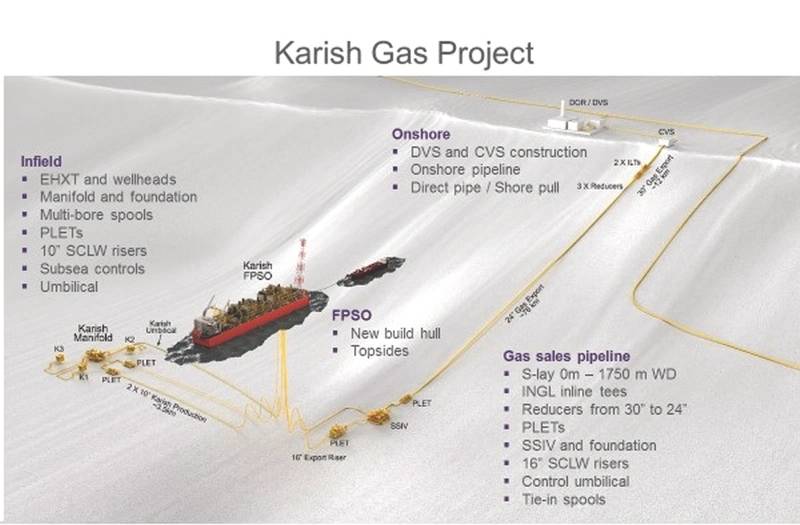
An integrated approach to subsea services is the driving force behind a major project being performed by UK-based TechnipFMC at the deepwater Karish field, offshore Israel, in the Mediterranean Sea.
The integrated engineering, procurement, construction and installation (iEPCI) award for Energean Oil & Gas’ Karish development at 1,750 meters water depth marks the largest iEPCI project the company has undertaken to date.
The $1.4 billion Karish gas project is one of 12 iEPCI projects TechnipFMC has been awarded throughout the globe. The company’s approach to comprehensive integrated solutions is designed to strengthen the economics of subsea projects and help unlock first oil and gas faster.
The integrated full-field subsea offer includes subsea architecture design; subsea development and integrated project execution; and optional performance enhancement via inspection, maintenance and repair.
“Bringing together complementary skills and advanced technologies through integrated solutions can boost efficiency, lower costs and accelerate schedules,” said Senior Project Director Steve Duthie.
Streamlining the process
The technologically differentiated approach of iEPCI better manages the complete work scope and streamlines every part of the process. Among the benefits:
To support its integrated efforts, the company has built high-tech facilities near the world’s main offshore oil and gas producing basins. The facilities include subsea hardware, flexible pipe, umbilical and reeled rigid pipe welding/spooling manufacturing plants, plus a fleet of specialized vessels for pipeline installation, subsea construction, diving support and heavy lift.
Seabed to FPSO
TechnipFMC has been a partner in the Energean Karish project since the concept stage in 2017, delivering an offering that extends from seabed to offshore producing facility. First gas is expected in the first quarter of 2021.
“Karish is an excellent demonstration of an efficient integrated approach and showcases the added value it provides,” Duthie said.
“The iEPCI approach means that one company takes care of all the interfaces. And that means the client no longer has to worry about that, so the cost and schedule can be reduced.”
The execution of the Karish iEPCI contract covers the design, procurement, construction and installation of the complete subsea system, a floating production storage and offloading unit (FPSO) 90 kilometers offshore named Energian Power that will enable the tieback of the Karish field, the pipeline system, and the onshore pipeline and valve station at the receiving station.
The Karish project is an example of working collaboratively across several different businesses to provide an integrated solution.
Duthie is responsible for both the subsea and onshore elements and leads the Karish team based in Aberdeen, UK. “This is the first project where we are responsible for the onshore parts of the work alongside an FPSO facility, the full subsea production system and the subsea, umbilical, riser and flowline installation,’’ he said.
The FPSO is being handled through the company’s Paris operations with some of the topside modules being designed and managed at the Lysaker, Norway office. The onshore scope is being delivered by operations in Rome and subsea umbilicals from Newcastle, UK. The trees and the wellheads are coming from Dunfermline, UK, while the subsea production system work and drilling tools support are being performed in Kongsberg and Bergen, Norway. Other elements are being provided by US-based affiliate Genesis in Houston, Texas.
“We are supplying a cost-effective, integrated iEPCI solution displaying product lines, service hardware installation and engineering and project management capabilities,” Duthie said.
 The Karish gas field development, located in the Mediterranean Sea in 1,750 meters of water, marks TechnipFMC’s largest iEPCI project to-date. (Image: TechnipFMC)
The Karish gas field development, located in the Mediterranean Sea in 1,750 meters of water, marks TechnipFMC’s largest iEPCI project to-date. (Image: TechnipFMC)
Marginal fields
The iEPCI model also can be used to unlock marginal fields. The shallow water systems offer turnkey, cost-effective solutions for tieback wells in jackup water depths to open revenues in marginal fields.
This is accomplished through enhanced design, optimized installation and a lean project team.
iEPCI satellite tieback systems provide a competitive solution for marginal fields and stranded assets. It’s a pre-engineered solution for developing smaller fields close to existing infrastructure.
Early engagement
The energy industry is beginning to appreciate the benefits from an early engagement, technology-enabled iEPCI model. More industry specialists are talking about integration, but the benefits to the operator are dependent on the degree of project integration. Full integration requires early engagement at the FEED stage to optimize field design and remove interfaces and schedule waste. It requires having all capabilities under one roof to manage the trade-offs inherent in optimizing solutions.
More than surface level, the integrated approach goes deeper by merging two subsea leaders in SPS and SURF to deliver a full water column solution. Integrated services can simplify development solutions, optimize subsea architecture, reduce contractual risks, deliver cost savings and enhance overall value.
 The Author: Willy Gauttier began his career with TechnipFMC in 1996 in Norway with Coflexip Stena Offshore. He currently serves as executive project director of the Karish Gas Development Project in Israel, which is the first fully integrated project for TechnipFMC.
The Author: Willy Gauttier began his career with TechnipFMC in 1996 in Norway with Coflexip Stena Offshore. He currently serves as executive project director of the Karish Gas Development Project in Israel, which is the first fully integrated project for TechnipFMC.